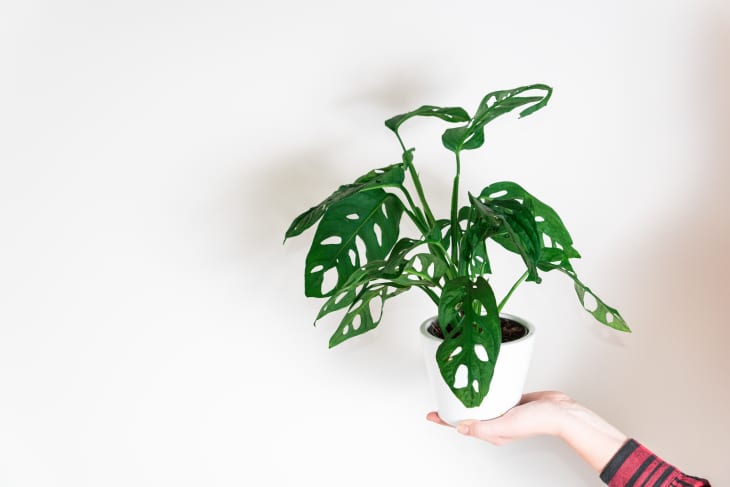By now you’re probably well acquainted with Monstera deliciosa—that gigantic, sculptural houseplant straight out of Mad Men that currently appears in roughly 75 percent of all design bloggers’ Instagram posts. It’s adored equally for being easy to grow and looking good next to a mid-century sofa. But have you met its cousin, Monstera adansonii? Because we’d really like to introduce you.
Monsteras are often called Swiss cheese plants or vines for their leaves’ lacy holes and notches, and adansonii is arguably the cheesiest of them all. Its leaves are more perforated and delicate than deliciosa‘s and the plant is petite in comparison. And though all Monsteras are considered vines, adansonii has a trailing quality that makes it a good pick for hanging baskets or training around a room.
As with many plant species, there is a lot of confusion about the different types. You might hear them called friedrichsthalii by sellers and growers (which appears to be the same thing), or more commonly obliqua, which others say is not the same at all.
How to Care for Monstera Adansonii
For all its delicate beauty, growing Monstera adansonii is fairly straightforward. Plant it in a pot with drainage holes using a standard potting soil that contains peat. (Peat helps to trap moisture without becoming waterlogged.) It will look best in a hanging basket or in a pot on a high shelf or somewhere else where its trailing vines can be shown off to advantage without getting in the way. Put the plant near a window where it will receive bright, but indirect, sunlight. Trim the vines as needed if they start to look scraggly to encourage new growth.
Watering is the trickiest part of caring for Monsteras. They like consistently moist soil but don’t want to be soggy. They also like high humidity, which can especially be a challenge in winter, so consider using a humidifier. Yellowing leaves are a common issue and indicate that something about your watering schedule is off. Test the soil with a finger before you water: at least the top inch should be dry. On the flip side, make sure you’re not giving it so much water that the top layer of soil remains wet for several days at a time. Watering once a week should do the trick, though you might need to experiment with frequency based on the temperature and humidity in your home.
Toxicity
According to the ASPCA, Monstera plants are toxic to animals. If you decide to get one, make sure you put it where your cats and dogs can’t eat the leaves, which can cause irritation, mouth swelling, excessive drooling, vomiting, and difficulty swallowing.
Propagation
It’s easy to grow baby Monstera adansonii from your current plant. Snip off a section of vine that includes at least two nodes (those knobby bits where the leaves form). Set the vine in a glass of water until roots form and then plant the cutting in soil. You’ll have a brand new plant to give to a friend or trade at a plant swap.
Hải Yến
Gió bạn với cây tự buổi nào ,
Gió về cây lại ngất ngư chao .
Gió đi cây sẽ im lìm đứng,
Như kẻ lỡ làng dạ khát khao .
Hải Yến
Gió bạn với cây tự buổi nào , Gió về cây lại ngất ngư chao . Gió đi cây sẽ im lìm đứng, Như kẻ lỡ làng dạ khát khao .




